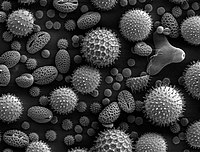
Photo from wikipedia
Abstract Objective: To determine the prevalence of allergic rhinitis and associated factors in adolescents and in their parents/guardians. Methods: A cross-sectional study, applying a standardized and validated written questionnaire. Adolescents… Click to show full abstract
Abstract Objective: To determine the prevalence of allergic rhinitis and associated factors in adolescents and in their parents/guardians. Methods: A cross-sectional study, applying a standardized and validated written questionnaire. Adolescents (13–14 years old; n=1,058) and their parents/guardians (mean age=42.1 years old; n=896) living in the city of Uruguaiana, southern Brazil, responded to the Global Asthma Network standard questionnaires. Results: The prevalence of allergic rhinitis in adolescents was 28.0%, allergic rhinoconjunctivitis, 21.3%, and severe forms of allergic rhinitis, 7.8%. In the adults, the prevalence of allergic rhinitis was 31.7%. Some associated factors with allergic rhinitis in adolescents include low physical exercise (OR 2.16; 95%CI 1.15–4.05), having only one older sibling (OR 1.94; 95CI 1.01–3.72) and daily meat consumption (OR 7.43; 95% CI 1.53–36.11). In contrast, consuming sugar (OR 0.34; 95%CI 0.12–0.93) or olive oil (OR 0.33; 95%CI 0.13–0 .81) once or twice a week, and eating vegetables daily (OR 0.39; 95%CI 0.15–0.99) were considered factors negatively associated. In adults, exposure to fungi at home (OR 5.25; 95%CI 1.01–27.22) and consumption of meat once or twice a week (OR 46.45; 95CI 2.12–1020.71) were factors associated with the medical diagnosis of allergic rhinitis, while low education (OR 0.25; 95%CI 0.07–0.92) was found to be a factor negatively associated. Conclusions: The prevalence of allergic rhinitis in adolescents is high, as well as its medical diagnosis in adults living in Uruguaiana. Environmental factors, especially food habits, were associated with findings in both groups.
Journal Title: Revista Paulista de Pediatria
Year Published: 2023
Link to full text (if available)
Share on Social Media: Sign Up to like & get
recommendations!